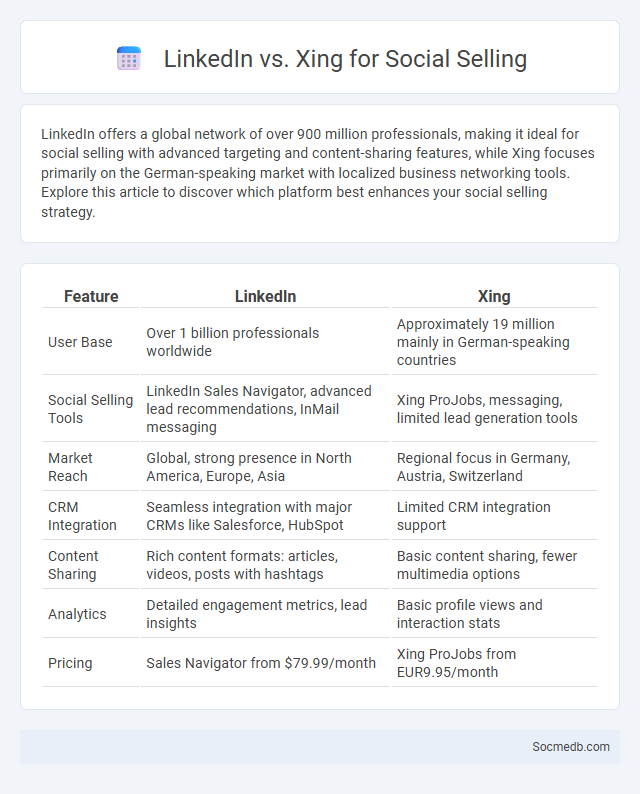
Photo illustration: LinkedIn vs Xing for Social Selling
LinkedIn offers a global network of over 900 million professionals, making it ideal for social selling with advanced targeting and content-sharing features, while Xing focuses primarily on the German-speaking market with localized business networking tools. Explore this article to discover which platform best enhances your social selling strategy.
Table of Comparison
| Feature | ||
|---|---|---|
| User Base | Over 1 billion professionals worldwide | Approximately 19 million mainly in German-speaking countries |
| Social Selling Tools | LinkedIn Sales Navigator, advanced lead recommendations, InMail messaging | Xing ProJobs, messaging, limited lead generation tools |
| Market Reach | Global, strong presence in North America, Europe, Asia | Regional focus in Germany, Austria, Switzerland |
| CRM Integration | Seamless integration with major CRMs like Salesforce, HubSpot | Limited CRM integration support |
| Content Sharing | Rich content formats: articles, videos, posts with hashtags | Basic content sharing, fewer multimedia options |
| Analytics | Detailed engagement metrics, lead insights | Basic profile views and interaction stats |
| Pricing | Sales Navigator from $79.99/month | Xing ProJobs from EUR9.95/month |
Overview of LinkedIn and Xing: Key Differences
LinkedIn serves as a global professional networking platform with over 900 million users, emphasizing career development, job searching, and industry news. Xing primarily targets German-speaking countries, offering localized networking, job opportunities, and events tailored to Central European professionals. Your choice between LinkedIn and Xing depends on whether you seek international reach or regional focus in your professional connections.
What is Social Selling? An Introduction
Social selling is the process of leveraging social media platforms like LinkedIn, Twitter, and Facebook to identify, connect with, and nurture potential customers. This strategy focuses on building meaningful relationships and trust through personalized engagement rather than traditional sales tactics. By sharing relevant content and insights, businesses can influence buying decisions and drive revenue growth.
Social Selling on LinkedIn: Features and Tools
LinkedIn's social selling tools include LinkedIn Sales Navigator, which offers advanced search filters, lead recommendations, and real-time insights to help professionals identify and engage potential clients effectively. The platform's messaging features, such as InMail, enable personalized outreach to decision-makers beyond immediate connections, enhancing relationship-building opportunities. Integration with CRM systems and detailed analytics further empower sales teams to track engagement metrics and optimize their social selling strategies on LinkedIn.
Social Selling on Xing: Features and Tools
Social Selling on Xing leverages advanced features like personalized profiles, targeted messaging, and industry-specific groups to help you connect with potential clients and decision-makers effectively. Tools such as Xing Events and the Sales Navigator enable precise lead generation and relationship management, enhancing your outreach and engagement strategies. Optimizing your presence with these functionalities increases your chances of converting connections into valuable business opportunities.
Audience Demographics: LinkedIn vs Xing
LinkedIn attracts over 900 million professionals globally, with a strong presence in North America, Europe, and Asia, primarily aged 25-34, and a balanced gender distribution emphasizing business, technology, and finance industries. Xing serves around 20 million users mainly in German-speaking countries such as Germany, Austria, and Switzerland, skewing older with a concentration in the 35-54 age group, and is popular among professionals in manufacturing, engineering, and consulting sectors. Audience engagement on LinkedIn is higher due to global reach and extensive content features, while Xing offers localized networking and deeper connections within its core markets.
Lead Generation Effectiveness: LinkedIn vs Xing
LinkedIn generates 80% more qualified leads for B2B companies compared to Xing, making it the preferred platform for business professionals seeking to expand their network. The advanced targeting algorithms on LinkedIn increase lead conversion rates by 25%, while Xing's reach remains primarily regional, limiting exposure for international campaigns. Maximizing Your lead generation effectiveness requires leveraging LinkedIn's data-rich insights and extensive user base to connect with decision-makers globally.
Content Strategies for Social Selling on Both Platforms
Effective content strategies for social selling on social media involve creating tailored, value-driven posts that resonate with the target audience on platforms like Instagram and LinkedIn. Utilizing high-quality visuals and authentic storytelling on Instagram boosts engagement, while sharing industry insights and thought leadership articles on LinkedIn establishes credibility and trust. Consistent interaction through comments, direct messages, and personalized content further enhances relationship-building and conversion rates.
Networking Opportunities: LinkedIn vs Xing for Sellers
LinkedIn and Xing offer valuable networking opportunities for sellers by connecting you with potential clients and industry professionals globally and regionally, respectively. LinkedIn's vast international user base enables access to diverse markets, while Xing's concentrated presence in German-speaking countries enhances targeted networking within Europe. Choosing the right platform depends on your sales goals and target audience location to maximize relationship-building and lead generation.
Analytics and Performance Tracking Compared
Social media analytics tools offer in-depth data on user engagement, reach, and demographic insights, enabling you to track your content's performance effectively. Platforms like Facebook Insights, Twitter Analytics, and Instagram Insights provide comparative metrics that highlight trends and audience behavior across different channels. Leveraging these analytics empowers your marketing strategy to optimize content delivery and maximize ROI.
Platform Pros and Cons for Social Selling Success
Social media platforms each offer unique advantages and challenges for social selling success. Instagram's visual-centric interface drives high engagement but requires consistent content creation, while LinkedIn excels in B2B networking with robust targeting options but often demands professional tone and time investment. Understanding your audience and leveraging platform-specific features can maximize your social selling potential.
 socmedb.com
socmedb.com